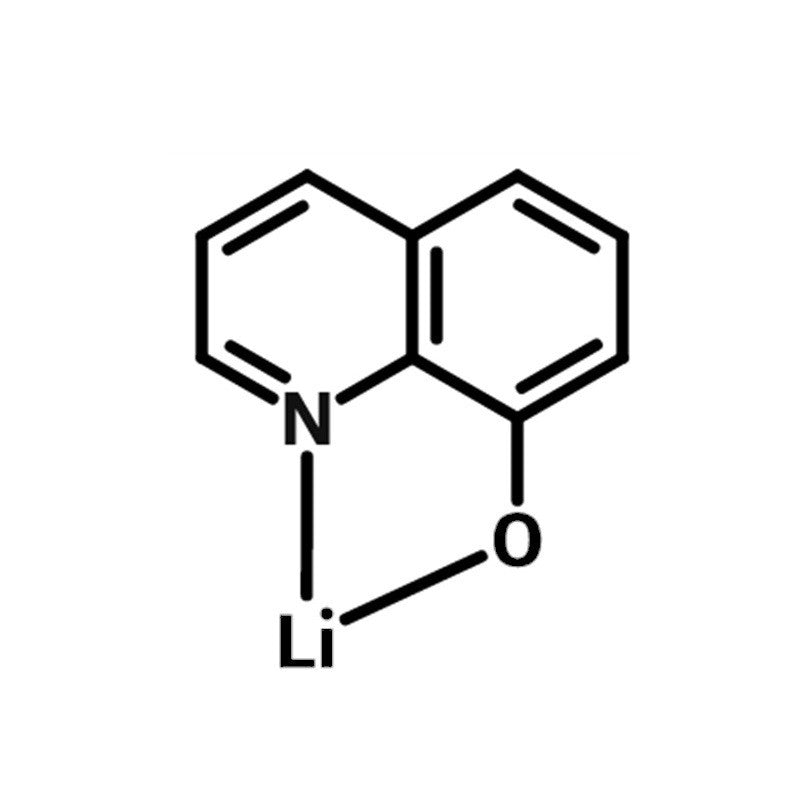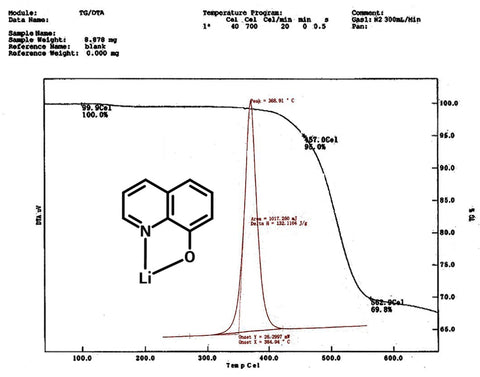Charge Transport Layer Materials, Electron Injection Layer Materials, Electron Transport Layer Mater


8-Hydroxyquinolinolato-lithium (Liq), coupled with aluminum (Al), is commonly used as an electron injection layer (EIL) material in organic electronic devices, particularly OLEDs. Normally, only a very thin layer (1-2 nm) Liq is needed for efficient electron injection from the electrode to the electron transport layer (ETL).
Liq/Al has also been widely known to be an effective cathode system towards general electron transport layer materials. It has also been reported that ultrathin Liq interlayers can greatly enhance the operational stability of light-emitting diodes [2].
| CAS number | 25387-93-3 |
|---|---|
| Chemical formula | C9H6LiNO |
| Molecular weight | 151.09 g/mol |
| Absorption | λmax 261 nm (in THF) |
| Fluorescence | λem 331 nm (in THF) |
| HOMO/LUMO | HOMO = 5.58 eV, LUMO = 3.15 eV [1] |
| Synonyms | Liq, Lithium-8-hydroxyquinolinolate, Lithium 8-quinolinolate, 8-Hydroxyquinolinolato lithium |
| Classification / Family | Electron transport layer (ETL) materials, Organic Light-Emitting Diodes, Organic electronics, Sublimed materials |
| Purity | >99% (sublimed), >98% (unsublimed) |
|---|---|
| Melting point | 366-368 ºC (lit.) |
| TGA | Td ≥ 430 oC (5%) |
| DSC | Tm =365 oC (+/- 1oC) |
| Colour | Light yellow powder |
*Sublimation is a technique used to obtain ultra pure-grade chemicals. For more details about sublimation, please refer to the Sublimed Materials.
 Chemical Structure of 8-Hydroxyquinolinolato-lithium (Liq)
Chemical Structure of 8-Hydroxyquinolinolato-lithium (Liq)
| Device structure | ITO (150 nm)/NPB (70 nm)/mCP:Firpic-8.0%:Ir(ppy)3-0.5%:Ir(piq)3-0.5% (30 nm)/TPBi (30 nm)/Liq (2 nm)/Al (120 nm) [3] |
|---|---|
| Colour |
White |
| Max. Luminance | 37,810 cd/m2 |
| Max. Current Efficiency | 48.1 cd/A |
| Device structure | ITO (180 nm)/TAPC (60 nm)/mCP:Firpic–8 wt% (10 nm)/Ir(ppz)3 (1.5 nm)/mCP:Firpic–8 wt% (10 nm)/Ir(ppz)3 (1.5 nm)/mCP:Firpic–8 wt% (10 nm)/TPBi (30 nm)/Liq (2 nm)/Al (120 nm) [4] |
|---|---|
| Colour |
Blue |
| Luminance@200 cd/m2 | 32,570 cd/m2 |
| Max. Current Efficiency | 43.76 cd/A |
| Max. EQE | 23.4% |
| Max. Power Efficiency | 21.4 lm W−1 |
| Device structure | Al/MoO3 (3 nm)/mCP (50 nm)/Ir(tfmppy)2(tpip)* (0.5 nm)/TPBi (2.5 nm)/mCP (2.5 nm)/Ir(tfmppy)2(tpip) (0.5 nm)/TPBi (10 nm)/Bphen (45 nm)/Liq (1 nm)/Al (1 nm)/Ag (22 nm)/mCP (80 nm) [5] |
|---|---|
| Colour |
Green |
| Max. Current Efficiency | 126.3 cd/A |
| Device structure | ITO/ NPB (70 nm)/DPVBi:BCzVBi (15 wt%, 15 nm)/ADN:BCzVBi (15% wt%, 15 nm)/BPhen (30 nm)/ Liq (2 nm)/Al (100 nm) [6] |
|---|---|
| Colour |
Deep Blue |
| Max. Luminance | 8,668 cd/m2 |
| Max. Current Efficiency | 5.16 cd/A |
| Device structure | ITO/NPB/DPVBi:BCzVBi-6%/MADN:DCM2-0.5%/Bphen/Liq/Al [7] |
|---|---|
| Colour |
White |
| Max. Luminance | 15,400 cd/m2 |
| Max. Current Efficiency | 6.19 cd/A |
| Device structure | ITO/PEDOT:PSS (40 nm)/ CzDMAC-DPS* (40 nm)/TPBI (40 nm)/Liq (1.6 nm)/Al (100 nm) [8] |
|---|---|
| Colour |
Greenish-Blue |
| Max. Current Efficiency | 30.6 cd/A |
| Max. Power Efficiency | 12.2 lm W−1 |
| Device structure | ITO/HTL (100 nm)/CBP:9 wt%DACT-II*(40 nm)/BAlq (30 nm)/Liq/Al [9] |
|---|---|
| Colour |
Green |
| Max. EQE | 41.3% |
*For chemical structure information, please refer to the cited references.
 TGA and DSC trace of 8-Hydroxyquinolinolato-lithium (Liq).
TGA and DSC trace of 8-Hydroxyquinolinolato-lithium (Liq).专业代理国外知名镊子品牌
我们将竭诚为你服务
0755-23003036